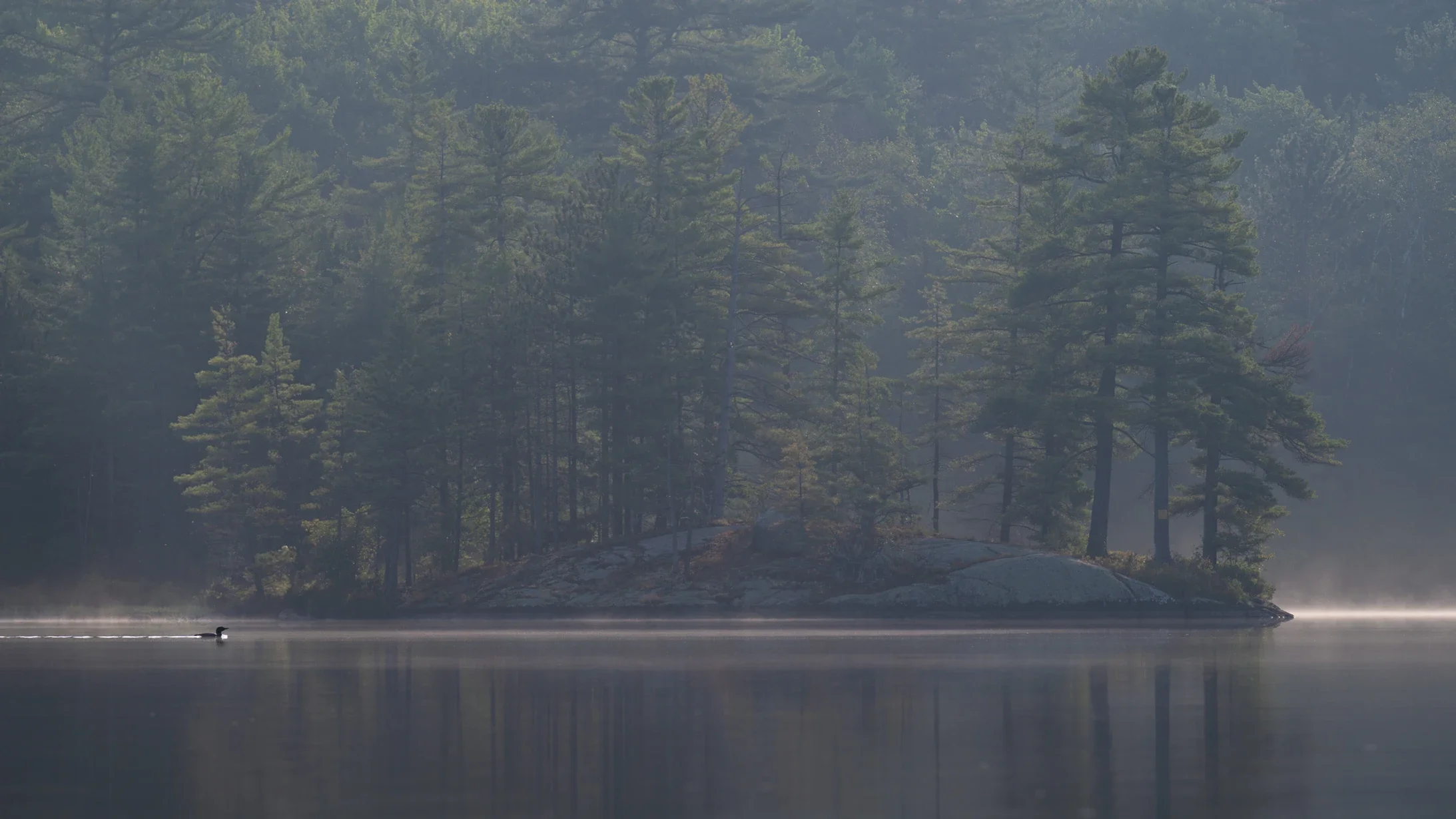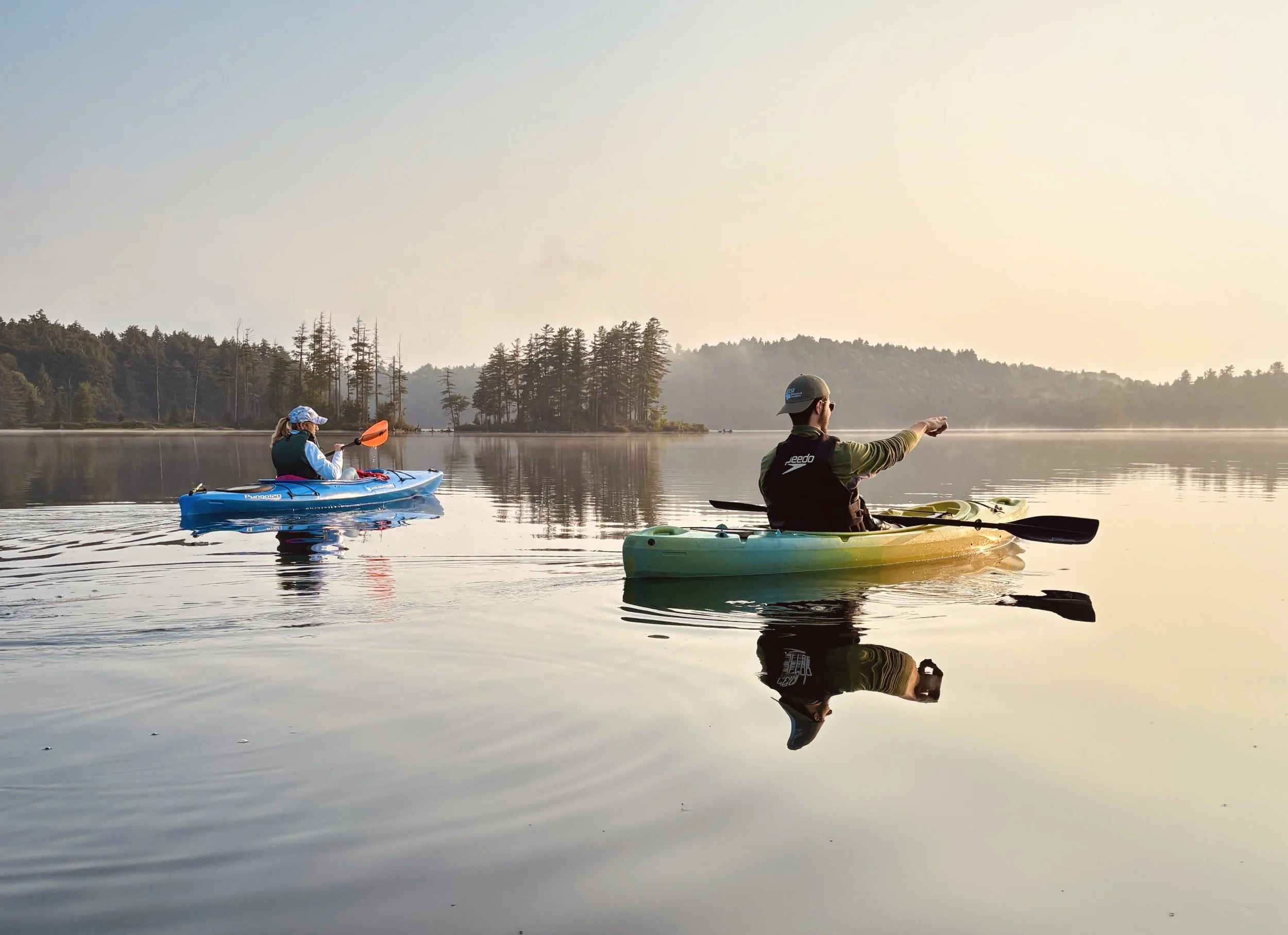ACLC Hosts Wildlife Photography Paddles
The Adirondack Center for Loon Conservation (ACLC) was thrilled to partner with wildlife photographer Andrew Hudnut in early August to host two wildlife photography paddles aimed at teaching participants about loons and responsible wildlife viewing, while also offering tips and tricks for wildlife photography. Andrew wrote the following blog about the experience. If you are interested in seeing more events like this, email ACLC at education@adkloon.org. You can also contact Andrew through his website about his private guided paddles.
Words & Images by Andrew Hudnut, Wildlife Photographer
On a cool, foggy Saturday morning, I joined four enthusiastic paddlers for a guided wildlife photography session on Little Clear Pond in Saranac Lake, hosted with the Adirondack Center for Loon Conservation. The clock read 6:30 a.m. when we gathered at the launch, the sun beginning to burn off the fog as distant loon calls echoed across the still water.
By 6:51, we were gliding into the golden light.
Before we pushed off, I shared a few of my favorite wildlife photography tips from years of shooting on the water: getting low and eye-level with your subject, watching for the “heat ripple” effect later in the day, and always being ready for the unexpected. I also reminded everyone that in wildlife photography, nothing is guaranteed - you may paddle for hours without spotting your target species, or take hundreds of frames without that “perfect” shot. The magic comes from being out there, ready for when the moment does happen.
Photo by Emma Borys
Our first surprise came quickly - a Merlin perched high in the treetops, busy preening in the soft glow of the morning sun. It stayed long enough for everyone to get a good series of shots, the light highlighting every detail of its feathers.
As we were photographing the Merlin, a Belted Kingfisher announced itself with its signature rattle. It darted down to a low branch, dove into the water, and vanished—only to return moments later. This time, it perched backlit by the low sun, giving us a rare opportunity to capture the delicate details of its silhouette.
Eventually, we turned our attention to our main goal: photographing loons. Common Loons are iconic Adirondack birds, famous for their eerie calls and black and white checkering plumage. They are powerful divers, able to swim more than 200 feet underwater in search of prey, and are fiercely territorial during breeding season.
We paddled into the territory of a loon pair with a chick, but initially found only the mother and chick far off near shore. As we watched from a respectful distance, the mother began preening—running her bill through her feathers to keep them clean, waterproof, and aligned. At one point, she began to do a foot waggle, showing of some bands!
Not long after, the male loon appeared from behind us, coming from the direction of another loon gathering. He gave a tremolo call - an alarm-like vocalization often used to signal agitation or call a mate’s attention. The female tremoloed back, swimming toward him. Before long, the two stashed the chick close to shore and swam away together.
In the distance, another pair of loons swam toward the rising sun, making tracking difficult. After 20 minutes of trying to follow their silhouettes, we decided to return to the chick’s territory. When we arrived, the adults were gone, leaving the chick hunkered close to shore—an unmistakable defense mechanism chicks use when parents are away. I quickly pointed it out to the group, reminding them not to approach so the chick could remain safe.
Just as we were turning to a new point of interest, Emma spotted something unusual—a group of seven loons out on the lake. As we paddled closer, the number kept growing: eight, nine, ten loons together in one spot. Among them were the chick’s parents, who were not at all pleased about this crowd near their territory.
Suddenly, chaos erupted. Loons dove aggressively beneath the surface, others peered underwater for incoming threats, and the air was filled with splashing and wing rows. Loons use their sharp bills as spears, capable of seriously injuring or even killing rivals in territorial disputes.
We watched in awe as several loons eventually took to the air—two or three lifting off in powerful, long takeoff runs before disappearing over the horizon. (Loons need a long “runway” of open water to become airborne, upwards of 600 feet.) Once the battles subsided, the mother returned to her chick, and calm settled over the pond once more.
On our way back to the launch, we stopped for one last check-in and found the chick safely reunited with its mother. The two calmly preened side by side, and flapped their wings several times (but my camera died!).
This particular loon pair has not successfully raised a chick in about five years, so she seemed especially vigilant, often stashing her baby while fending off intruding loons. It was a privilege to witness her fierce protection and tender care in the same morning.
What was supposed to be a session ending at 8:30 stretched nearly two hours longer—but none of us minded. Between the intimate moments with the mother and chick, the unexpected raptor encounters, and the rare spectacle of a large loon gathering, it was a sunrise paddle none of us will soon forget. Even without a guarantee of sightings, mornings like this remind us that the most unforgettable wildlife photography moments are often the ones you couldn’t have planned.












